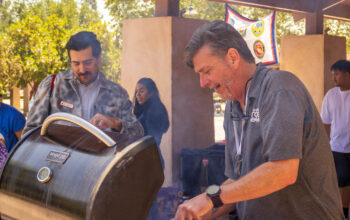Alyssa Attakamon / Roundup
Even in the age of digital technology, vinyl records remain valuable to audiophiles and collectors.
Chrystal Walsh, a 26-year-old journalism student, shared her earliest memories.
“My mom and some other relatives collected records. When I was a child I would look at all their records dating back to the ‘30s, at least early ‘40s. A lot of Big Band records,” Walsh said.
Bruce Roberts, clerk at Flip Side Records in Woodland Hills, grew up in the ‘40s when vinyl records were prominent.
Roberts stressed, “One of the reasons that vinyl is so popular is that there’s a certain warmth that comes through the needle which isn’t there on the CDs because they’re pure digital. A lot of music collectors think that CDs are too cold and impersonal—they want that presence, that warmth, and that includes all the pops and hisses that come with the vinyl.”
A vinyl record, or gramophone record, is a flat disc with grooves that begin in the middle.
Records vary in size and also play at different speeds indicated by revolutions per minute (RPMs).
Each record stores between one and 25 minutes per side, depending on the physical size of the disc.
A demand for vinyl records has increased for many reasons.
“I really like the fact that the album art is so large. On CDs, it’s just a tiny little picture,” Walsh said.
Though not yet an avid collector, Walsh said, “If I see anything that might be a valuable collector’s item, I will pick it up and if not, I might pick up a couple others of my favorite artists.”
Collectors young and old are in a constant search for classics like Elvis Presley. Even newer bands such as Tiger Army and Thrice have released albums on vinyl.
Walsh mentioned her next possible buy.
“With U2’s new album, I bought the CD. It was released in vinyl so I will pick that up, too,” she said.
With digital music from stores like iTunes or Amazon, music can be downloaded instantly and loaded onto a portable music player in minutes. Instant gratification and convenience are part of a theme of today’s age. The space records once took up on shelves is now free in many homes.
“You have to look at the whole picture,” Roberts said. “Because when vinyl records came out, you had turntables and then you had amplifiers. Amplifiers have changed over the years, too. Now they have chips and transistors. When you look at the old era, there was a great big vacuum tube in them. The tone that comes out of those tubes with the speakers can’t be beat.”
“A business still exists in this economy for collectors from all over the world as well,” Walsh added. “There’s a group of Japanese men that come through the record stores here in the Valley and in Hollywood, that go through usually early ‘50s rock ‘n’ roll.
“They can buy a record here, even stacks, maybe pay $10 to $20 per record. Taking it back to Japan, they’re probably selling them for $50 to $100 because they’re even rarer over there than over here,” Walsh said.
There are a handful of record stores still in business in Woodland Hills alone.
It remains clear that the market for such a particular item continues to resonate in today’s popular culture. A list of record stores in the L.A. area is available at http://www.studio-nibble.com/guides/losangeles.html

(Aisha Ahal / Roundup)



